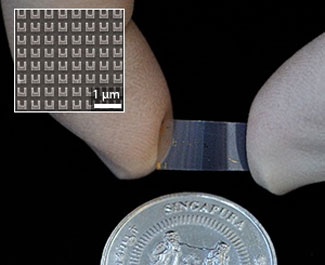| Sep 05, 2011 |
Metamaterials on a stretch provide dynamic properties
|
|
(Nanowerk News) Metamaterials are remarkable microstructures that are able to control and bend light almost at will, promising technologies as exotic as invisibility cloaks. One of the factors that has limited their potential applications, however, is the high rigidity of existing metamaterials, which renders them unable to adjust to their surroundings.
|
|
Qihua Xiong and researchers from Nanyang Technological University and A*STAR in Singapore have now demonstrated a flexible metamaterial that manipulates light at infrared and visible wavelengths and can mold to almost any surface ("Flexible Visible–Infrared Metamaterials and Their Applications in Highly Sensitive Chemical and Biological Sensing"). |
|
"These flexible, transparent, transformable and biocompatible metamaterials are very promising for future photonic device applications," says Xiong.
|
 |
| A light-weight flexible metamaterial prepared by depositing gold and silver optical elements on a stretchable polymer sheet.
|
|
The designed microstructural elements that give metamaterials their unusual light-manipulation properties must be much smaller than the wavelength of light that they effect. To light, metamaterials therefore appear as conventional, homogeneous materials, but the minute variations imparted by each metamaterial element have a collective effect on the flow of light through the medium. Although invisibility cloaking is one of the more fantastic possible applications of these materials, they also hold much promises for applications in medical diagnostics and ultrahigh-resolution imaging.
|
|
So far, most metamaterials have been constructed by depositing metallic nanostructures on rigid substrates. This means that the properties of these metamaterials are locked in as soon as they are fabricated. Xiong and his team instead deposited metamaterial elements on a polymer substrate (see image) using electron-beam lithography and a thermal evaporation process in which tiny gold and silver metamaterial structures were deposited with great care to ensure that the polymer substrate remained intact.
|
|
Using their fabrication method, the researchers prepared a metamaterial for chemical and biological sensing. The device was able to detect very low concentrations of small organic molecules as well as a larger protein based on a shift in the optical resonance of the metamaterial.
|
|
The broader potential of these metamaterials, however, is the flexibility and stretchability of the metamaterial sheets thus produced. Stretching the plastic substrate leads to small changes in the shape of the metamaterial structures and associated changes in optical properties. "Military applications such as cloaking or redirecting electromagnetic waves are attractive future applications — it is technically feasible using our fabrication method to wrap a layer of light-weight metamaterial around an object."
|

